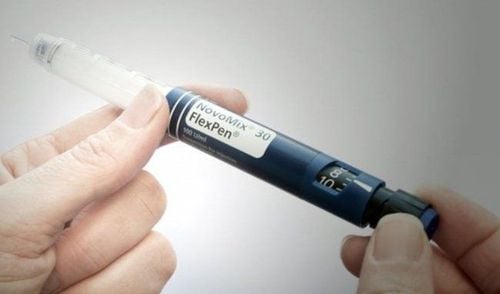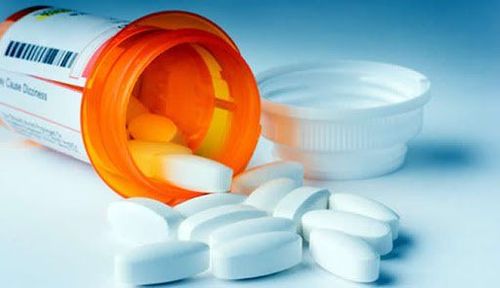This is an automatically translated article.
Diaprid 2 has the main ingredient Glimepiride, which belongs to the group of antidiabetic drugs, is made in the form of 2 mg tablets, manufactured by Pymepharco pharmaceutical joint stock company.1. What is Diaprid 2 mg?
Diaprid 2 mg is prescribed by a doctor for use in adults with non-insulin dependent diabetes mellitus type 2, when blood glucose levels cannot be controlled by exercise and diet. simple weight.
2. Contraindications of Diaprid 2 mg Insulin-dependent diabetes mellitus. Renal failure, severe liver failure. Diabetic ketoacidosis. Hypersensitivity to the drug components, other sulfonylureas. Pregnant or planning to become pregnant. Breastfeeding women. Diabetic coma or coma, diabetic coma. Cases of acute illness.
3. Side effects when using Diaprid 2 mg
Common:
Nervous: Dizziness, dizziness, headache. Gastrointestinal: Nausea, vomiting, feeling of fullness in the epigastrium, abdominal pain, diarrhea. Eyes: At the start of the drug there is usually a temporary visual disturbance, due to a change in blood glucose levels. Uncommon:
Skin: Allergic or pseudo-allergic reactions, redness, urticaria, itching. Rare:
Liver: Increased liver enzymes, jaundice, impaired liver function. Blood: Mild or severe thrombocytopenia, hemolytic anemia, red blood cells, leukopenia, agranulocytosis. Vascular: Allergic vasculitis. Skin: sensitive to light.
4. Drug interactions
Glimepiride is metabolised in the liver by cytochrome P450 (CYP 209). Its metabolism will be altered in combination with inducers of CYP2C9 (such as rifampicin) or with inhibitors of CYP2C9 (such as fluconazole).
Interactions to note:
Increased hypoglycaemic effect: Hypoglycaemia may occur when Diaprid 2 mg is used together with drugs Phenylbutazone, Azapropazone, Oxyphenbutazone; Insulin and oral antidiabetic agents; antibiotics such as Ciprofloxacin, Pefloxacin...; salicylates and para-aminosalicylic acid, some non-steroidal anti-inflammatory drugs (NSAIDs); anabolic steroids and male sex hormones; Chloramphenicol, some long-acting sulfonamides, tetracyclines; coumarin anticoagulants; Fenfluramine; Fibrates; ACE inhibitors; Fluoxetine, MAOIs. Allopurinol, Probenecid, Sulfinpyrazone; sympathomimetic agents; Cyclophosphamide, Trofosfamide and Ifosfamide; Miconazole, Fluconazole; Pentoxy Lilin (in high doses by injection); Tritoqualin. Reduce blood glucose lowering effect of some drugs: Progestatif and Estrogen; Thiazide diuretics and salt-reducing diuretics; glucocorticoids, thyroid hormone-like drugs; Chlorpromazine derivatives, Phenothiazines; Adrenaline and sympathomimetic drugs nicotinic acid (in high doses), nicotinic acid derivatives; laxatives (when used long-term); Diazoxide, Phenytoin; Barbituric, Glucagon and rifampicin; Acetazolamide. Increases or decreases the blood glucose lowering effect of some drugs: Histamine H1 receptor antagonists; beta-blockers, Guanethidine, Clonidine, Reserpine; Drinking alcohol while taking the drug can unpredictably increase or decrease the hypoglycaemic effect of Diaprid 2 mg; Glimepiride may potentiate or decrease the effects of coumarin anticoagulants.
5. Notes when using the drug Diaprid 2 mg
Glimepiride as well as other sulfonylureas can cause hypoglycemia (blood glucose level falls below 60 mg/dl equivalent to 3.5 mmol/l). Hypoglycemia can occur with drug overdose, inadequate eating, erratic, skipping meals, prolonged strenuous exercise, alcohol consumption. Hypoglycaemia is more common in the elderly, in patients with renal and hepatic impairment. Patients who are stable on glimepiride therapy may become uncontrollable under stress (trauma, surgery, febrile infections). It may then be necessary to use insulin, in combination with glimepiride, or as insulin alone instead of glimepiride. People with a deficiency of the enzyme glucose-6-phosphate dehydrogenase. 6. How to use Diaprid 2 mg effectively How to use:
Usually take the drug once a day right before or during breakfast or lunch. Swallow the tablet whole, do not break the pill. Dosage:
Starting 1 mg x 1 time / day. Then, every 1-2 weeks, if blood glucose is not controlled, increase the dose by 1 mg/day, until blood glucose is controlled. The maximum dose of glimepiride is 8 mg/day. Usually, patients respond to doses of 1 - 4 mg/day, rarely to 6 or 8 mg/day. Doses higher than 4 mg/day only have better results in some special cases. The dose must be adjusted in the following cases:
If there is hypoglycaemia after taking 1 mg of Glimepiride, the patient can only need to be treated with diet and exercise. The dose of Glimepiride should be changed to avoid hypoglycemia when: The patient's weight changes. The patient's lifestyle changes. There are combinations with drugs or factors that can increase or decrease blood glucose. Impaired liver and kidney function: Switching from other antidiabetic drugs to Glimepiride Using a combination of Glimepiride and Metformin or Glitazone: Using a combination of Glimepiride and insulin Note: The above dosages are for reference only and should not be used used without the consent of the doctor. The specific dose depends on the condition and the progression of the disease. To get the right dose, you need to consult your doctor or healthcare professional.
7. Overdose of Diaprid 2 mg
Symptoms:
Nausea, vomiting and epigastric pain. Hypoglycemia may be accompanied by neurological symptoms such as fatigue, sweating, cold skin, tremors, restlessness, visual disturbances, coordination problems, drowsiness, coma, convulsions, headache, anxiety, tachycardia, increased blood pressure, nervousness, restlessness, chest tightness, arrhythmia, hunger pangs, nausea, vomiting, drowsiness, decreased reaction, decreased concentration, decreased flexibility, sensory disturbances, speech disturbances, mild paralysis, dizziness, impaired consciousness, somnolence, depression, confusion, loss of consciousness, leading to coma. Treatment:
Mild cases: Treatment mainly consists of blocking the absorption of the drug into the body by inducing vomiting, then immediately giving glucose or white sugar 20-30 grams mixed in a glass of water and monitoring. blood glucose. Give it once every 15 minutes, continue to drink until blood glucose returns to normal. If large amounts have been ingested, gastric lavage is indicated, followed by activated charcoal and sodium-sulphate. Severe cases: The patient is comatose or unable to drink, must be taken to the emergency room and given 50 ml of 50% glucose solution intravenously, then a slow intravenous infusion of 10-20% glucose solution to gradually increase blood glucose. to normal limits. It is necessary to continuously monitor blood glucose for 24-48 hours because it is easy to develop recurrent hypoglycemia. If severe, 1 mg glucagon can be administered subcutaneously or intramuscularly. If too much glimepiride is taken, gastric lavage and activated charcoal should be given.
8. Preservation and caution when taking Diaprid 2 mg. Storage:
Store in sealed packaging at a temperature of 30oC, away from heat, light and moisture. Caution:
Hypoglycemia: Glimepiride must be taken immediately before or during a meal. When meals are not regularly scheduled or missed, treatment with Glimepiride may lead to hypoglycemia. Treatment with Glimepiride requires frequent monitoring of blood and urine glucose levels. Furthermore, the rate of glycosylation of hemoglobin should also be determined. Regular hematological and hepatic monitoring (especially white blood cells and platelets) is required during treatment with Glimepiride. For conditions such as stroke, emergency surgery, infection with fever... temporarily change to using insulin. Patients with severe renal or hepatic impairment should be switched to insulin. In summary, Diaprid 2 mg is indicated for use in adults with non-insulin dependent type 2 diabetes. Patients should carefully read the instructions for use, consult a doctor / pharmacist before using to ensure safety for health.
Please dial HOTLINE for more information or register for an appointment HERE. Download MyVinmec app to make appointments faster and to manage your bookings easily.













